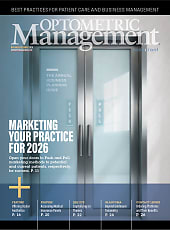DIPLOPIA is caused by various factors, including muscle imbalances and neurologic problems, and it can be debilitating for patients. The primary goal of treatment is to restore binocular vision. While traditional methods like prism glasses or patching are effective, custom soft contact lenses (SCLs) offer a more versatile and cosmetically appealing alternative.
Monocular Diplopia
Monocular diplopia causes a patient to see a “ghost image” that persists even when 1 eye is covered. It can be caused by uncorrected astigmatism, media opacities, or retinal disease. For a patient who has regular astigmatism, a standard toric SCL usually resolves the issue.
However, to treat irregular astigmatism, custom SCLs can be designed with increased center thickness to provide pseudorigidity and mask the irregular surface. This can reduce the distortion caused by the higher-order aberrations that appear as diplopia, and the resulting over-refraction may be correctable by adding a regular toric correction to the lens (Lampa, 2023).
Binocular Diplopia
For binocular diplopia, which disappears when 1 eye is covered, custom SCLs can be used in 3 main ways: monovision, occlusion, or with directional prism. Each approach targets a specific diplopia mechanism—sensory suppression, symptomatic masking, or optical alignment—allowing individualized treatment.
Monovision intentionally blurs 1 eye at distance to improve near vision. The brain is forced to suppress the vision in the other eye, which can help eliminate diplopia (Lee et al, 2025).
Occlusion uses an opaque SCL with a black pupil area that completely blocks vision in 1 eye, like an eye patch. This is best for intractable diplopia (Astin, 1998). It’s advantageous to choose a pupil diameter 2 mm to 3 mm larger than the patient’s mesopic pupil size. SCLs with an opaque iris and a clear pupil can also be used to create a pinhole effect, which blocks peripheral light and can improve vision in cases of correctopia or a fixed-dilated pupil.
Custom SCLs that use directional prism can have up to 4.0 prism diopters (PD) of base-down (BD) prism to correct small vertical deviations in both spherical and astigmatic lenses (SpecialEyes, 2014). Commercially available toric SCLs also tend to induce small amounts of BD prism depending on their stabilization design (Sulley et al, 2015). Eyelid-stabilized designs induce nearly 0 PD, whereas periballast designs range from 0.52 PD to 1.15 PD (Sulley et al, 2015).
Ultimately, SCLs can only incorporate BD prism, but custom scleral lenses, especially impression-based sclerals, can incorporate up to 5.0 PD in any direction. Sclerals have the added benefit of being rotationally stable, despite their increased thickness with prism.
Clinical Considerations
A thorough eye exam is crucial for determining the cause of double vision and to assess whether prism glasses can resolve the issue before a patient is fitted with SCLs. It’s also important to counsel patients that monovision and occlusion sacrifice binocular depth perception, which can affect things like judging distances.
In some patients who have monocular astigmatism, a vertical prism disparity of more than 0.5 PD between the eyes can cause symptoms like asthenopia, nausea, headaches, and visual discomfort, and may decrease stereopsis (Sulley et al, 2015). Clinicians should be mindful of this, especially when prescribing CLs for patients with vertical phorias, and be alert to patient complaints (Nilsson et al, 2008).
SCLs are a valuable tool for managing diplopia. With careful lens selection and fitting, they can improve a diplopia patient’s visual function, comfort, and appearance.
References
1. Lampa M. Custom soft lenses for irregular astigmatism. Rev Optom. 2023 Aug 15. reviewofoptometry.com/article/custom-soft-lenses-for-irregular-astigmatism
2. Lee SK, Zabrowski C, Lee MS. Management of diplopia using contact lens. Neuro-ophthalmology. 2024;49(1):11-16. doi: 10.1080/01658107.2024.2377173
3. Astin CL. The use of occluding tinted contact lenses. CLAO J. 1998;24(2):125-7.
4. SpecialEyes. Benefits of customizing prism with custom soft toric contact lenses 2014. blog.specialeyesqc.com/custom-soft-toric-contact-lenses-and-the-benefits-of-customizing-prism
5. Sulley A, Hawke R, Lorenz KO, Toubouti Y, Olivares G. Resultant vertical prism in toric soft contact lenses. Cont Lens Anterior Eye. 2015;38(4):253-257. doi: 10.1016/j.clae.2015.02.006
6. Nilsson M, Stevenson SB, Leach N, Bergmanson JP, Brautaset RL. Vertical imbalance induced by prism-ballasted soft toric contact lenses fitted unilaterally. Ophthalmic Physiol Opt. 2008;28(2):157-162. doi: 10.1111/j.1475-1313.2008.00538.x



